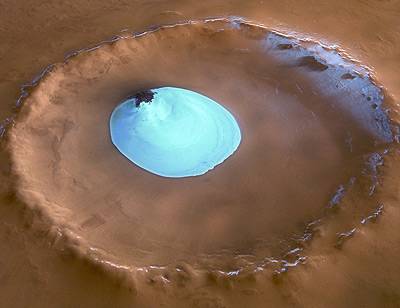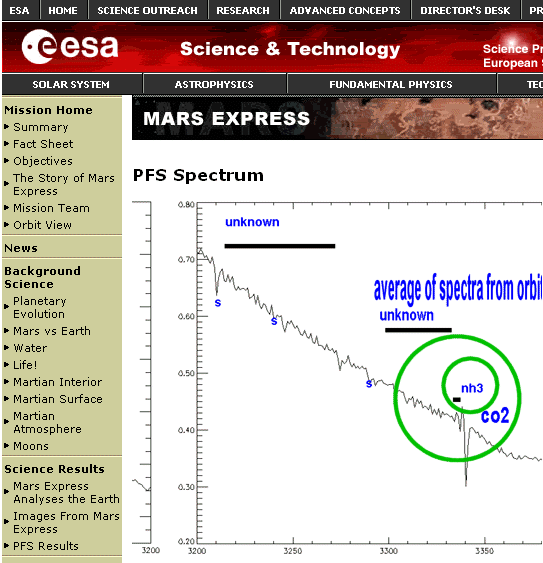See also:
| The "Mars" section of this site. | |
| Latest Mars exobiology news. | |
| Latest news from the Mars Global Surveyor probe. | |
| Latest news from the Mars Odyssey probe. | |
| Latest news from the Beagle 2 / Mars Express probes (This page). | |
| Latest news from the Mars Spirit and Opportunity probes. |
| 12.01.2005 | ESA radar reveals water below Martian surface. |
| 07.30.2005 | ESA's Mars Express finds water ice in Martian crater. |
| 06.12.2005 | ESA gives OK for deployment of second Marsis boom. |
| 02.27.2005 | Life on Mars: scientists say yes. |
| 02.23.2005 | New scientist: More Martian water evidence, and deeper too. |
| 02.22.2005 | Scientists share an historic Mars Express moment. |
| 02.22.2005 | Scientists suspect a frozen lake on Mars. |
| 08.15.2004 | The detected/not detected ammonia on Mars found again, at ESA's web site. |
| 07.27.2004 | No, ammonia not detected on Mars. |
| 07.19.2004 | Ammonia detected, one more evidence for present life on Mars. |
| 01.24.2004 | Dark features at the bottom of Valles Marineris. |
| 01.23.2004 | First data from Mars Express confirms ice water in the south polar cap. |
| 01.23.2004 | First images from Mars Express confirms water erosion features. |
| 01.15.2004 | Forthcoming Mars daily weather reports. |
| 12.26.2003 | Beagle 2 lander still silent in second contact attempt. |
| 12.25.2003 | Beagle mission to Mars: landing status report. |
| 12.19.2003 | Beagle mission to Mars: successfull separation from mothership. |
| 11.27.2003 | European probe soon to land on Mars. |
| 06.02.2003 | And France too: successful launch for Mars Express. |
Science magazine reports that ESA's MARSIS radar antenna aboard Europe's Mars Express spacecraft probed under the icy deposits at the north pole of Mars and revealed that they are 1.8 km thick in the region studied.
Tantalizing hints of liquid water pooling in a buried impact crater were also found. A 250-kilometer-wide circular structure that lies between 1.5 and 2.5 kilometers below the surface of Chryse Planitia is an impact crater that was buried with volcanic ash or soil several billion years ago. The team sees no radar boundaries in material that fills the bowl of the crater and the radar signals lose little strength when passing through it. That suggests the infill must contain a large proportion of ice, which is nearly transparent to radar.
The signal reflected from the bottom of the crater is so strong and appears so flat that it may be liquid water. "If you put water there, that's what the signal might look like," said William Johnson, MARSIS manager.
The image above was taken by the High Resolution Stereo Camera (HRSC) on board ESA's Mars Express spacecraft. It show a patch of water ice sitting on the floor of an unnamed crater near the Martian north pole.

|
Images with a ground resolution of approximately 15 meters per pixel show residual water ice in the crater which has 35 kilometers wide crater and maximum depth of approximately 2 kilometers beneath the crater rim.
The ice is present permanently as the temperature and pressure are not high enough to allow its sublimation. Traces of water ice are also visible along the rim of the crater and on the crater walls.
Source and credit is ESA at http://www.esa.int/SPECIALS/Mars_Express/SEMGKA808BE_1.html
After the deployment of the first MARSIS antenna boom on board of ESA's Mars Express, there were concerns over the deployment of the second boom. But ESA has now decided to proceed with its deployment, during a time frame starting June 13 and ending on June 21.
This will allow more data on Mars water to be gathered.
European Space Agency scientists have said they think that there was and could still be life on Mars at the end of a one-week conference during which scientists from around the world discussed ESA's Mars mission findings so far.
After finding a 800 by 900 kilometers and at least 50 meters deep ice sea near Mars' equator, formed less than 5 million years ago and methane emerging from the same area, as well as and formaldehyde, Vittorio Formisano said: "Hints of life on Mars are getting stronger" and "Life is probably the only source that can produce so much methane" and The question is not any more, Was there life on Mars? The question is: Is there life on Mars today?"
Everett Gibson, from NASA's Johnson Space Centre, said he had held a poll among the 250 scientists at the conference. On the question whether they thought there had been life on Mars, 75 percent replied in the affirmative. Asked whether they believed there to be life now, 25 per cent said "yes". Asked what kind of life, Gibson said "bacterial".
ESA scientists want a new European mission to the ground of Mars to take samples.
The New Scientist magazine reports at www.newscientist.com/article.ns?id=dn7026 on the latest discoveries from ESA's Mars Express probe.
They note that while there is abundant evidence which points to the activity of running and standing water across the face of Mars, there were so far very few signs of the minerals that the interaction of water and volcanic rocks should produce - such as carbonates and sulphates, except for hematite, a water-altered iron mineral.
But now new data from the Omega visible and near-IR imaging spectrometer onboard ESA's Mars Express found a large region - 60 kilometers by 200 km - that shows the clear spectral signature of calcium-rich sulphates, probably gypsum. This means that at least a portion of that northern "ocean" area was indeed covered by standing water for a long time.
Opportunity was able to confirm directly that haematite and other water-altered minerals reached a depth of about 30 meters, but the Omega spectra now show that those same deposits extend hundreds of meters deeper. They are also exposed at various levels in the etched terrain to the north - the kind of terrain where Opportunity landed.
The ESA team wrote: "Our results imply that aqueous processes were involved in forming and/or altering the etched terrain materials over distances of hundreds of kilometers and throughout a several-hundred-meter thickness, and thus extends the proven record of water to a stretch of time at least ten times greater than previously thought."
As a large area of Mars is both the area where pack ice above frozen watery soil and methane emissions are located, Jan-Peter Muller of the University College London said in a statement today:
"This is a historic moment for Mars exploration when a previously neglected region reveals its secrets."
"Speculations that this area might have water close to the surface have been shown to be correct."
The findings could be important for biology, Muller and his colleagues say.
"Higher levels of methane over the same area mean that primitive micro-organisms might survive on Mars today."
Study co-leader John Murray at the Open University in the UK said in today's statement:
"The fact that there have been warm and wet places beneath the surface of Mars since before life began on Earth, and that some are probably still there, means that there is a possibility that primitive micro-organisms survive on Mars today."
"This mission [ESA's Mars Express] has changed many of my long-held opinions about Mars: we now have to go there and check it out."
A scientific team based on ESA's Mars Express probe data have written a paper on a possible current frozen sea or lake with surface pack-ice, located near the equator. The paper is submitted to Nature magazine due March and will be discussed at the Lunar and Planetary Science Conference 2005 on March 18.
The paper can be read at: http://www.lpi.usra.edu/meetings/lpsc2005/pdf/1741.pdf
Here is a good one.
ESA's Professor Formisano found ammonia on Mars, said BBC News. Then, Nature magazine said Formisano now insists he has not discovered ammonia on Mars (see previous news on this page).
On the ESA web site, the contrary has been published:
http://sci.esa.int/science-e/www/object/index.cfm?fobjectid=34633
"One composite PFS spectrum generated from over 1600 measurements. Revealed is the detail of the existing data and indicates some of the unanswered questions. The gaseous species are indicated: CO, CO2, H2O, HDO, NH3, S is for solar line. The solar spectrum is essentially unknown in half of the PFS region - these are the first space measurements at medium spectral resolution of the solar spectrum. To determine if a line is of solar, or Martian origin is a challenging task. There are many regions with features detected that are not yet identified."
Ammonia is practically proof that there is existing life on Mars (in addition to the many other evidence, see the rest of the Mars section).
Here is the spectrum published by ESA showing ammonia, from their http://sci.esa.int/science-e/www/object/index.cfm?fobjectid=34633 page:

|
After the announcement by ESA's Dr. Formisano that his team has detected ammonia on Mars, journalists wanted to know more: indeed the discovery of ammonia would practically be evidence of present life since conditions on Mars degrade ammonia fast and there is no geological process which may produce it constantly.
However, Formisano has now insisted to science magazine Nature that he has not detected ammonia. He has only "optimistically suggested that his team might have done so" in a recent conference abstract.
Another scientist, Mike Mumma, said his team has spent ten years looking for ammonia and never seen it, and that Formisano cannot see it because the Mars Express instrument is not fit to see it.
The spectral signature of ammonia has been tentatively detected by by the Planetary Fourier Spectrometer (PFS) sensor on board the Mars Express probe of the European Space Agency.
Exactly as methane, a previously detected clue of biological activity, ammonia cannot survive more than a few hours in the Martian atmosphere. This means it must be constantly produced.
Methane and ammonia are interpreted by opponents of the life on Mars theory as coming from active volcanoes. But no active volcano of volcanic hotspot has been found on Mars despite intensive search. The only known alternative is that ammonia and methane are biological products, probably from Martian microbes.
Professor Vittorio Formisano, responsible scientist for the Fourier spectrometer, is expected to release details of new findings from the PFS at an international conference being held next week in Paris.
The detection of ammonia comes just a few months after methane was found in the Martian atmosphere. Methane is another gas with a possible biological origin.
Ammonia is that it is a compound of nitrogen and hydrogen. Nitrogen is rare in the Martian environment. Because no ordinary form of terrestrial life can exist without it, the presence of ammonia is one more of the increasing number of evidence that there is some sort of biological activity on Mars today still.
A NASA scientist said, "there are no known ways for ammonia to be present in the Martian atmosphere that do not involve life."
(See announcement cancellation above).
The data is flooding in too fast to make sense of some mysterious features, such as a dark splotch in Mars's grand canyon and along some valleys, he said. They may be sediments that OMEGA will be able to identify.
Image number: SEMBY9474OD
Caption: Reull Vallis - HRSC image 15 January 2004
Credits: ESA/DLR/FU Berlin (G. Neukum)

|
Mars Express directly measured water in the form of ice on the southern polar cap. This southern polar cap water was long suspected, but only found more than plausible last year when images from Mars Global Surveyor indicated defrosting holes in the layer of several meters of frozen CO2 covering this suspected water.
The principal investigators of the spacecraft's presented their results at a press conference in Darmstadt, Germany on Friday. The instrument that made the measurement, OMEGA, searches for the telltale signature of molecules such as water by studying the spectra of sunlight reflected from Mars.
Previous measurements made by Odyssey had indicated the presence of water near the surface of Mars by counting hydrogen neutron, though, skeptics were not convinced under the motive that hydrogen is not only telltale sign of water, although they did not name another compound than water which may reasonably has been found in such amounts and locations. One scientist said that "It's too early to tell whether the water ice means the south pole is simply colder than expected or whether there is more water than expected."
Bibring said he and his team would release data on how much water they measured at a future date. Next week they will also look for water ice on the northern polar cap, which is already known to exist there.
Other water-related results include a measurement of oxygen ions being blown off the planet's atmosphere by charged particles that make up the solar wind. The oxygen ions were most likely coming from atmospheric water vapor, which is known to exist in trace amounts.
Spectacular images and videos made from the High Resolution Stereo Camera (HRSC) of Mars Express have been released today.
Sinuous channels and pits similar to those eroded by water on Earth were imaged at a few meters' resolution, in full color, and in 3-D. "I think we can say, yes, there was water acting on the surface of Mars," said Gerhard Neukum, principal investigator of the HRSC.
The European Space Agency (ESA) which set up the Mars Express and Beagle 2 mission, said today it hoped to provide a daily weather report from Mars soon. Data will be provided by an experiment aboard the Mars Express spacecraft, which is now on its final stable orbit.
While the orbiter has no problem, the Beagle 2 lander remained silent on a second contact attempt by the British radio telescope facility at Jodrell Bank at 19:00 and 22:00 to midnight GMT. The search will continue in coming days using the Mars Odyssey spacecraft now in orbit and deep space ground stations at Jodrell Bank and Stanford.
ESA reports (www.esa.int) that at 03:45 CET, 25 December 2003, that "at 03:45 CET today, the Beagle 2 lander should have entered the Martian atmosphere. The Mars Express orbiter began its main engine ignition sequence to start the 34-minute main engine burn for achieving Mars Orbit Insertion. At this time the two spacecraft will be 2700 kilometers apart in space as they began the most crucial stages of their missions."
But at 09:25 GMT, the BBC reports that scientists have failed to pick up an expected signal from British-built spacecraft Beagle 2 telling them it has landed safely on Mars.
The lander failed on its first try to make contact with ground controllers through NASA's Mars Odyssey spacecraft. Mission managers, however, said that the U.S. spacecraft would make another attempt to contact the lander later today as it passes once again over the Beagle 2 landing site. A radio telescope outside London also will try.
Michael McKay, one of the flight director with the European Space Agency, said: "We knew that this first contact was always a very cautious first signal. We're still very optimistic to receive a good signal in the coming days, and also to match the success of the Mars Express."
Mike McKay, flight operations director at the European Space Operations Centre (Esoc) at Darmstadt, Germany, confirmed that just after 11:10 GMT, Beagle 2 has successfully separated from its mothership for the final part of its journey to Mars.
The small probe will now glide the last three million kilometers to Mars on its own.
The lander is expected to touch down on Mars on Christmas Day, to search for signs of life, past or present. It has no propulsion system of its own and relies on accurate positioning to reach the desired landing site, a vast plain just north of the Martian equator. It will plunge towards the crater of Isidis Planitia slowed by a heat-resistant shield and parachutes, and cushioned by airbags for the landing.
Reminder: ESA's Mars Express probe is scheduled to arrive at Mars at Christmas: the Beagle 2 lander is expected to touch down on the surface of Mars during the night of 24 to 25 December.
CNES, the small French NASA counterpart, informs that the Mars Express was successfully launched from Baïkonur in Russia in the evening of June 2. The craft is correctly on its way to Mars, which it should reach in the end of December 2003. CNES reports: "The probe carries the Omega and Spicam instruments, developped under French expertise with support from CNES. In addition to the search for water and for possible lifeforms, scientists mainly hope to get a global view on Mars: its geology, its evolution."
Source www.cnes.fr